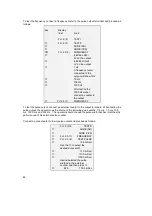
81
The meter now issues a stream of pulses with the set width. The running total of pulses sent
is shown on the display. The test stops when either 100,000 pulses have been sent or the
operator presses the
↵
key.
If the counter reads a smaller number than the actual number of pulses sent, or the frequency
meter under reads, then this indicates that a weak signal is reaching the frequency meter/pulse
counter. In this case try the following suggestions:-
(i)
Decrease the external pull-up resistor
(ii)
Decrease/remove the filter capacitor.
(iii)
Decrease the cable length between the converter and the counter.
(iv)
Add external buffers to boost the signal.
If the pulse counter reads a larger number than the converter, or if the frequency meter reading
is high or unstable, then this indicates the presence of external interference. Try one or more
of the following:-
(i)
Add/increase the size of the filter capacitor. (10 - 100nF)
(ii)
Use high quality screened cable.
(iii)
Keep cable lengths as short as possible, avoiding high power equipment/switchgear
and any cabling connected to them.
(iv)
Use external buffers.
8.1.4 Testing alarm output
This is a simple function that allows the alarm output to be tested at both its high and low
states.
8.1.5 Testing control input
Menu 2.5 allows the state of the control input signal to be tested.
Key
Display
line 1
line 2
Fct. 2.(3)
TEST P
↑
Fct. 2.(4)
TEST A
→
SURE (NO)
↑
SURE (YES)
↵
(LEVEL LOW)
0V on the output
↑
(LEVEL HIGH)
+24V on the output
↵
Fct. 2.(4)
TEST A
Key
Display
line 1
line 2
Fct. 2.(4)
TEST A
↑
Fct. 2.(5)
TEST INP.E
→
HI
RESET MASS
















































